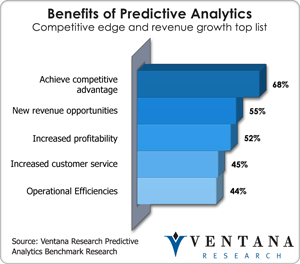PivotLink is a cloud-based provider of business intelligence and analytics that serves primarily retail companies. Its flagship product is Customer PerformanceMETRIX, which I covered in detail last year. Recently, the company released an important update to the product, adding attribution modeling, a type of advanced analytic that allows marketers to optimize spending across channels. For retailers these types of capabilities are particularly important. The explosion of purchase channels introduced by the Internet and competition from online retailers are forcing a more analytic approach to marketing as organizations try to decide where the marketing funds can be spent to best results. Our benchmark research into predictive analytics shows that achieving competitive advantage is the number-one reason for implementing predictive analytics, chosen by two-thirds (68%) of all companies and by even more retail organizations.
 Attribution modeling applied to marketing enables users to assign relative monetary and/or unit values to different marketing channels. With so many channels for marketers to choose among to spend their limited resources, it is difficult for them to defend the marketing dollars they allot to channels if they cannot provide analysis of the return on the investment. While attribution modeling has been around for a long time, the explosion of channels to create what PivotLink calls omnichannel marketing, is a relatively recent phenomenon. In the past, marketing spend focused on just a few channels such as television, radio, newspapers and billboards. Marketers modeled spending through a type of attribution called market mix models (MMM). These models are built around aggregate data, which is adequate when you have few just a few channels to calibrate, but it breaks down in the face of a broader environment. Furthermore, the MMM approach does not allow for sequencing of events, which is important in understanding how to direct spending to impact different parts of the purchase funnel. Newer data sources combined with attribution approaches like the ones PivotLink employs increase visibility of consumer behavior on the individual level, which enables a more finely grained approach. While market mix models will persist when only aggregate data is available, the collection of data in multiple forms (as by using big data) will expand the use of individual level models.
Attribution modeling applied to marketing enables users to assign relative monetary and/or unit values to different marketing channels. With so many channels for marketers to choose among to spend their limited resources, it is difficult for them to defend the marketing dollars they allot to channels if they cannot provide analysis of the return on the investment. While attribution modeling has been around for a long time, the explosion of channels to create what PivotLink calls omnichannel marketing, is a relatively recent phenomenon. In the past, marketing spend focused on just a few channels such as television, radio, newspapers and billboards. Marketers modeled spending through a type of attribution called market mix models (MMM). These models are built around aggregate data, which is adequate when you have few just a few channels to calibrate, but it breaks down in the face of a broader environment. Furthermore, the MMM approach does not allow for sequencing of events, which is important in understanding how to direct spending to impact different parts of the purchase funnel. Newer data sources combined with attribution approaches like the ones PivotLink employs increase visibility of consumer behavior on the individual level, which enables a more finely grained approach. While market mix models will persist when only aggregate data is available, the collection of data in multiple forms (as by using big data) will expand the use of individual level models.
PivotLink’s approach allows marketers and analysts to address an important part of attribution modeling: how credit is assigned across channels. Until now, the first click and the last click typically have been given greatest weight. The problem is that the first click can give undue weighting to the higher part of the funnel and the last click undue weighting to the lower end. For instance, customers may go to a display advertisement to become aware of an offer, but later do a search and buy shortly after. In this instance, the last-click model would likely give too much credit to the search and not give enough credit to the display advertisement. While PivotLink does enable assignment by first click and last click (and by equal weighting as well), the option of custom weighting is the most compelling. After choosing that option from the drop-down menu, the marketer sees a slider in which weights can be assigned manually. This is often the preferred method of attribution in today’s business environment because it provides more flexibility and often reflects better the reality of a particular category; however, domain expertise is necessary to apportion the weights wisely. To answer this particular challenge, the PivotLink software offers guidance based on industry best practices on how to weight the credit assignment.
Being based in the cloud, PivotLink is able to achieve an aggressive release cycle. Rapid product development is important for the company as its competitive landscape becomes crowded as on-premises analytics providers port their applications into the cloud and larger vendors look at the midmarket space for incremental growth. PivotLink can counter this by continuing to focus on usability and analytics applications for vertical industries. Attribution modeling is an important feature, and I expect to see PivotLink roll out other compelling analytics as well. Retailers looking for fast time-to-value in analytics and an intuitive system that does not need a statistician nor IT involvement, should consider PivotLink.
Regards,
Tony Cosentino
VP and Research Director










